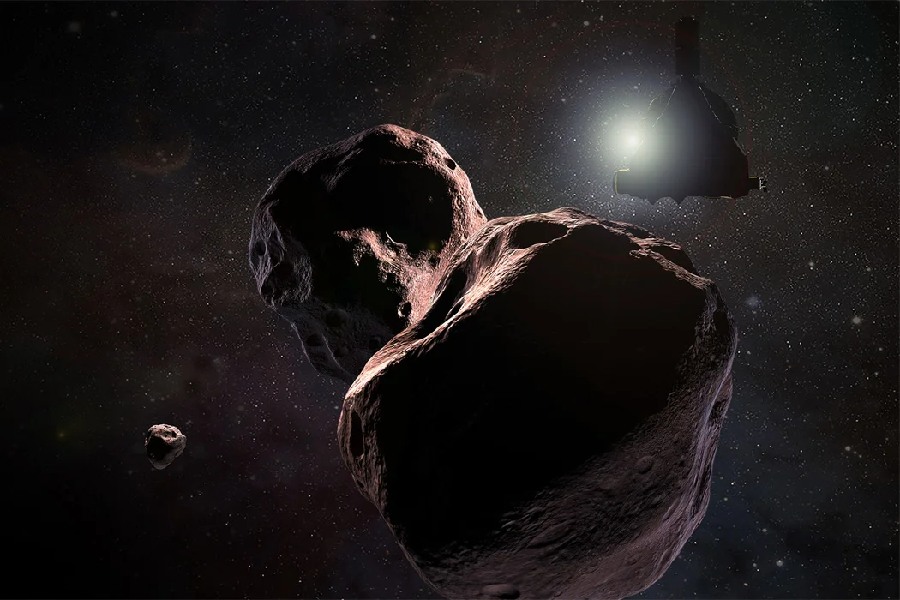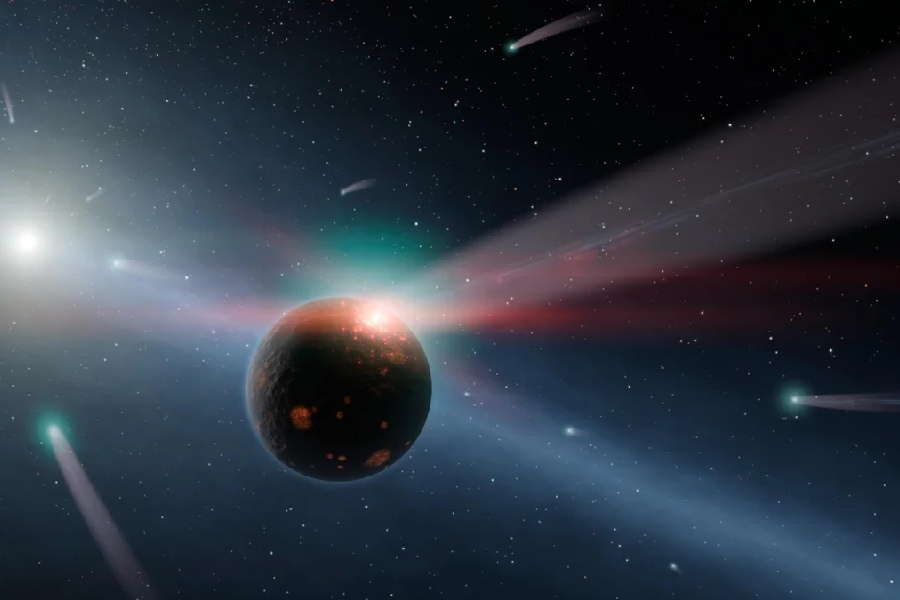Beyond Neptune’s orbit lies the mysterious Kuiper Belt, a distant, cold region filled with icy primordial remnants from our solar system’s early days. Far more frozen objects likely dwell there than in the Main Asteroid Belt. What can be found in the Kuiper Belt remains a mystery to this day, hiding its secrets hundreds of times further from the Sun.
Determining exactly what can be found opens a portal to untold mysteries. The contents of this obscure belt offer a glimpse into the solar system’s chemistry as it existed at the dawn of planet formation. The Kuiper Belt encompasses a range of objects from dwarf planets to comets to planetesimals.

What Can Be Found in the Kuiper Belt?
The Kuiper Belt is a region beyond Neptune in our solar system where icy objects, including dwarf planets like Pluto, are found. It’s like a distant cousin to the asteroid belt but much larger and farther away.
What is the Kuiper Belt made of besides Pluto? In addition to Pluto, there are many other small icy bodies, comets, and dwarf planets like Haumea and Makemake. These objects are leftover remnants from the early solar system and provide clues about its formation and evolution.
Pluto and Charon: Flagships of the Kuiper Belt
Clyde Tombaugh discovered Pluto at the Lowell Observatory in 1930. It was named the 9th planet but had odd traits, unlike inner worlds, with an inclined, more eccentric orbital path. Many wonder, is Pluto part of the Kuiper Belt that it orbits within? Yes, Pluto is considered the largest known member of the Kuiper Belt.
Though its surface wasn’t imaged until the 1990s with Hubble Space Telescope photos, as more icy Kuiper Belt objects were found beyond Neptune in the 1990s, calls strengthened to reclassify Pluto to match its kin. In 2006, the International Astronomical Union designated Pluto the first dwarf planet prototype.
No longer ranked as full-sized after 75 years, Pluto now leads the smaller, icy denizens populating the farther Kuiper Belt. Pluto’s Texas-sized moon Charon was revealed as a binary pair in 1978 but not resolved well until modern times.
Beyond Pluto: The Extended Kuiper Belt
The Kuiper Belt extends to great distances
The Kuiper Belt is concentrated near Pluto’s orbit. However, the belt likely stretches much further – to great distances barely explored so far. This sparsely populated outer area is known as the extended Kuiper Belt.
The presence of an extended Kuiper Belt is supported by the unusual elongated orbits of some discovered objects. For example, Sedna’s highly elliptical orbit reaches 9 times farther than Pluto at its farthest point (aphelion). This indicates the gravitational influence of an even more distant massive body.
Possibility of unseen larger worlds
Undiscovered dwarf planets or larger icy worlds may orbit in the extreme depths of the extended Kuiper Belt. Their feeble signals evade even the largest telescopes limited by light and resolution at these reaches of space.
But gravitational shepherding of extreme Kuiper Belt objects hints that hidden giant planets could lurk unseen far beyond Pluto. Their subtle gravitational sway leaves clues in the orbits of known tiny frigid denizens at the edge of space.
Impact on theories if found
Verification of a substantial planet beyond Pluto would carry a profound impact. It could supply a new focus target for studying composition and conditions. This would involve studying the primordial solar system 4 billion years back when worlds were forming.
It might also reshape prevailing theories on planetary migration. These theories dictate the structure observed in our solar system today, possibly aligned with undisrupted architecture from formation.

Comets: Icy Messengers from the Kuiper Belt
Kuiper Belt comets
Comets aggregated 4 billion years ago, just like Kuiper Belt objects. Composed of leftover ice, rock, and frozen volatiles that failed to become planets, comets preserve this earliest chemistry and conditions. Researchers ask, how many comets are in the Kuiper Belt? Estimates range greatly, but tens of billions is a reasonable count.
When occasionally perturbed today, comets get kicked inward toward the Sun. By shedding some surface materials, they form temporary atmospheres and tails upon nearing the Sun. These provide samples that can be studied in situ by spacecraft.
Spectroscopy of cometary comae reveals clues on the primordial outer solar system. Cometary comae contain a high fraction of pristine molecules like water ice, ammonia, and methane from ancient eras. More complex organics have also been detected in these comae.
Contrast inner vs outer system origins
Jupiter-family comets differ from Oort cloud members in both chemistry and orbits. This showcases variances in their composition. The variances are tied to each comet’s formation location in the early solar system. Studying comets helps trace historical planetary migration patterns.
Comet chemistry links delicately to the precise zero-pressure equilibrium conditions – the varied temperatures and compositions found across the early solar system at different regions.
Their journey into the inner solar system
Most Kuiper Belt comets are in classical short-period orbits. Gravitational kicks by giants like Neptune adjusted comet paths inward at times. This was especially common early on, when more turmoil existed. Their paths allow future passage through the inner system.
On inbound trajectories, comets feel growing warmth from the Sun. This triggers sublimation – expelled gasses and dust create glowing comae and swept-back tails. Sporadic meteors happen when debris collides with Earth’s atmosphere.
NASA, ESA, and JAXA have dispatched probes to intersect comets on bound orbits. Their goal is to analyze materials released directly from the nucleus up close.
Missions like Deep Impact and Stardust focused on long-period comet Tempel 1. Rosetta rendezvoused with short-period comet 67P. These missions have added enormously to our knowledge base.
Scattered Disk Objects: Beyond the Kuiper Belt
Scattered disk objects: extreme orbits & composition
Scattered disk objects (SDOs) occupy zones past the Kuiper Belt. Orbits are elliptical, inclined, and very eccentric. Cross Neptune’s orbit when nearest, then reach far beyond.
SDO orbits suggested once closer in the Kuiper Belt but gravitational interactions perturbed them outward over time. Remote icy remnants almost merge with deeper Oort cloud objects.
Scattered disk objects share water ice-rock composition with closer Kuiper Belt kin. Formed in similar epochs and regions before migrations outwards. Preserve comparable volatile materials and chemistry from the early solar system.
Examples of notable scattered disk objects
Eris presides over 3 times farther than Pluto’s aphelion. Nearly Earth’s moon size so classed as a dwarf planet, too. At 97 AU, one of the most remote detectable solid objects orbiting the Sun directly.
Sedna follows an incredibly elongated path. Travels as close as 76 AU and reaches almost 1000 AU away at Aphelion. The reddish surface still puzzles researchers on origins. Could its orbit have been shaped by an unseen massive planet?
2012 VP113 has a current perihelion near 80 AU, marking it among the most far-flung SDOs known. With an aphelion near 450 AU, it ventures deeper toward the Oort cloud than any other observed body.
Its long orbit likely formed closer inward earlier before perturbations drove this elongated track practically merging today. With the inner edge of the theorized Oort cloud spanning the solar system.
Mysteries and questions
Many open questions remain on Kuiper Belt objects’ origins, evolution, and intricate orbital dynamics. With estimates of trillions of unseen bodies implying complex early interplays. New Horizons images show Pluto’s puzzling landscapes – valleys and terrains hinting at ancient flowing liquids.
Diverse colors and brightnesses challenge models on original ice distributions. Upcoming spacecraft will probe Saturn’s moon, Titan, and the Kuiper Belt. While surveys catalog thousands more objects to reconstruct the motions and chemistry of this diverse family of worlds over time.
Conclusion
As we have explored, there is an array of intriguing objects hidden in the dimly lit depths of space. It’s a fascinating journey learning about what can be found in the Kuiper Belt. We hope readers have gained an appreciation for these last remnants of our solar system’s early days, locked in a deep freeze.
There is a vast diversity that has emerged from common origins over 4 billion years ago. From a myriad of tiny, icy fragments to dwarf planets holding onto their primordial air to the active messengers that are comets.
